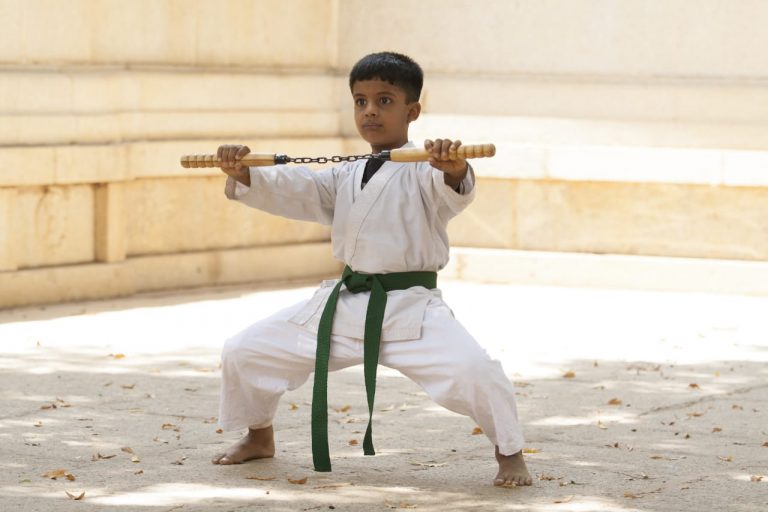karate
Karate (空手) is a martial art developed in the Ryukyu Kingdom.
[The Ryukyu Kingdom (English name: Lewchew, Luchu, and Loochoo) was an independent kingdom that ruled most of the Ryukyu Islands from the 15th to the 19th century. The kings of Ryukyu unified Okinawa Island and extended the kingdom to the Amami Islands in modern-day Kagoshima Prefecture and the Sakishima Islands near Taiwan. Despite its small size, the kingdom played a central role in the maritime trade networks of medieval East and Southeast Asia, especially the Malacca Sultanate.
HISTORY
The Ryukyu Islands also known as the Nansei Islands, “Southwest Islands” or the Ryukyu Arc is a chain of Japanese islands that stretch southwest from Kyushu to Taiwan: the Osumi, Tokara, Amami, Okinawa, and Sakishima Islands (further divided into the Miyako and Yaeyama Islands), with Yonaguni the westernmost. The larger are mostly high Islands and the smaller mostly coral. The largest is the Okinawa Islands.
The Ryukyu Kingdom was annexed by Japan in 1879. Karate was brought to the Japanese archipelago in the early 20th century during a time of migration as Ryukyuans, especially from Okinawa. It was systematically taught in Japan after the Taisho era.
In 1922, the Japanese Ministry of Education invited Gichin Funakoshi to Tokyo to give a karate demonstration. In 1924 Keio University established the first university karate club in mainland Japan and by 1932, major Japanese universities had karate clubs. In this era of escalating Japanese militarism, the name was changed from 唐手 (“Chinese hand” or “Tang hand”) to 空手 (“empty hand”) – both of which are pronounced karate in Japanese – to indicate that the Japanese wished to develop the combat form in Japanese style.
After World War II, Okinawa became an important United States military site and karate became popular among servicemen stationed there.

In 1429, the three kingdoms on Okinawa unified to form the Kingdom of RYUKYU. When King Sho Shin came into power in 1477, he banned the practice of martial arts. Tō-te and Ryukyu kobudō (weaponry) continued to be taught in secret. The ban was continued in 1609 after Okinawa was invaded by the Satsuma Domain of Japan. The bans contributed to the development of kobudō which uses common household and farming implements as weaponry.
Okinawans combined Chinese martial arts with the existing local variants to form Tōde (唐手Tuudii, Tang hand, China hand), sometimes called Okinawa-te (沖縄手Uchinaa-dii).

By the 18th century, different types of Te had developed in three different villages – Shuri, Naha, and Tomari. The styles were named Shuri-te, Naha-te, and Tomari-te, respectively.
Well into the 20th century, the martial arts of Okinawa were generally referred to as te and tii in Japanese and Okinawan for “hand”. Te often varied from one town to another, so to distinguish among the various types of te, the word was often prefaced with its area of origin; for example, Naha-te, Shuri-te, or Tomari-te.
Shuri-te, Naha-te and Tomari-te belong to a family of martial arts that were collectively defined as Tode-jutsu or To-de.
Karate (Okinawa-te or Karate-jutsu) was systematically taught in Japan after the Taisho era (after 1926).
The martial arts movies of the 1960s and 1970s served to greatly increase the popularity of martial arts around the world, and in English, the word karate began to be used in a generic way to refer to all striking-based Oriental martial arts]
Karate was developed under the influence of Chinese Kung Fu, particularly Fujian White Crane.
[White Crane Style is a Southern Chinese Martial Art that originated in Fujian province. According to oral tradition, the style was developed by Fang Qīniáng, Amoy Min Min, a female martial artist. It is associated with traditional fighting techniques, including long range, but is most similar to close-quarter or hand to hand combat. It is most recognizable by the way the fighter imitates a bird’s pecking or flapping of wings. While some white crane styles make use of traditional weapons, others have discontinued the use of weaponry.
Fujian White Crane is a type of Shaolin Boxing that imitates characteristics of the White Crane. An entire system of fighting was developed from observing the crane’s movements, methods of attack and spirit. It is one of the six well-known schools of Shaolin Boxing. The others are based on Tiger, Monkey, Leopard, Snake and Dragon and Additional, lesser-known schools include Dog, Deer, and Bear]
Karate is now predominantly a striking art using Punching, Kicking, Knee strikes, Elbow strikes and open-hand techniques such as Knife hands, spear-hands, and palm-heel strikes. Historically, and in some modern styles, grappling, throws, joint locks, restraints, and vital point strikes are also taught. A karate practitioner is called a karateka (空手家).
WANT TO START RIGHT NOW?
LEARN MORE ABOUT OUR CLASSES

ABOUT US
Parashurama Academy of Cultural Events (PACE) – established in 2010 – with the aim of promoting different forms of arts and cultural events in and across Karnataka and make the benefits of these art forms available for people lives in Karnataka. Currently PACE conduct classes for Kalaripayattu, Karate and Carnatic classical music (Vocal). Yoga, Musical instruments and different forms of dances are in plan and will be started soon.
